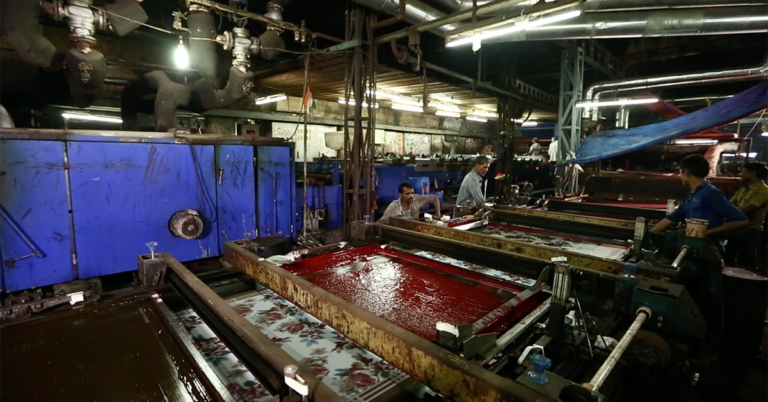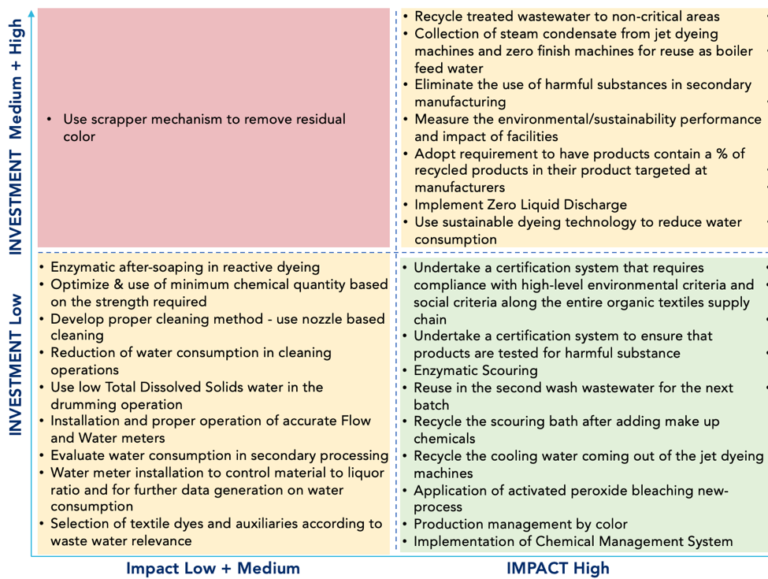
Industrial fabric dying/screening process. Photo credit: Institute for Sustainable Communities
Access to clean water is essential for community health and well-being, yet in India more than half the population faces high to extremely high water stress.[1] India is in the midst of a growing water crisis exacerbated by mismanagement and unsustainable use of water. The apparel industry — one of the largest and most intensive users of water — has a critical role to play to help stem the crisis as a steward for this resource.
Many apparel factories and fabric mills understand the water-related challenges and want to improve water security for their operations, the sustainability of their business, and their broader communities. However, it is an incredible challenge for these business owners to determine the technologies and approaches that are the best fit for their facilities and this can lead to inaction – putting lives, the economy, and the environment at risk.
The Women + Water (W+W) Alliance, a public-private partnership spearheaded by the U.S. Agency for International Development (USAID) and Gap Inc. aims to improve the health and well-being of women and communities touched by the apparel value chain. To advance the W+W Alliance, the Institute for Sustainable Communities (ISC) is working to accelerate the adoption of water stewardship practices across the Indian textile value chain.
Leveraging ISC’s extensive work with the manufacturing sector in India, wide networks of experts, and signature approach to stakeholder engagement, W+W recently completed a major milestone of this effort – researching, engaging with stakeholders, and then assembling a list of 90 best water stewardship practices, tools and guidelines across the textile value chain: from cotton production to primary and secondary processing to industry’s role at the community level. Once we completed the list of 90 water best practices, we categorized them by potential impact and cost (you can see an example of some of these practices in the chart below).
Water stewardship is defined by the CEO Water Mandate as,
“the use and treatment of water in ways that are socially equitable, environmentally sustainable, and economically beneficial. Ultimately, stewardship is a key practice to address critical water challenges, drive sustainable water management, and achieve the Sustainable Development Goals.”

Figure 1: Examples of secondary processing best practices for water use efficiency
Interestingly, based on discussions with industry and industry associations, W+W found that there is limited awareness about water stewardship as an integrated approach. While most textile industrial units (at primary and secondary textile value chain points) are aware of, or are implementing initiatives related to water stewardship, the concept of water stewardship is present in a fragmented manner. Textile units operating in regions with water stress were found to be aligned to the principle of water stewardship mostly as a compliance measure mandated by stringent local regulatory environment. For example, many textile processing units in the state of Tamil Nadu have internalized the cost of environmental compliance by implementing expensive technologies like zero liquid discharge (ZLD), while manufacturing facilities in other parts of India that have more relaxed regulations are less likely to have done so.
While these best practices were identified and assessed by seasoned experts, they remain largely untested as a cohesive water stewardship strategy. So, the W+W Alliance and ISC plan to use this list of best practices to design and implement tailored demonstration projects for cotton cultivation and textile manufacturing with the objective of building a real-world business case for these stewardship approaches so they can be scaled and adopted by the textile value chain at large. This will not only allow the implementers of stewardship approaches to capture the benefits from increased water quality and availability, but will also help surrounding communities, local economies, and the global supply chain to mitigate the impacts of water-related shocks and stressors.
By: Ishita Kapur – Senior Program Officer, Tarini Sahoo, PhD – Program Officer, and Richa Sharma – Program Officer, Institute for Sustainable Communities
This post does not represent the views or positions of the U.S. Agency for International Development, the U.S. Government, or Gap Inc.
[1] World Resources Institute, 2015, https://www.wri.org/blog/2015/02/3-maps-explain-india-s-growing-water-risks
